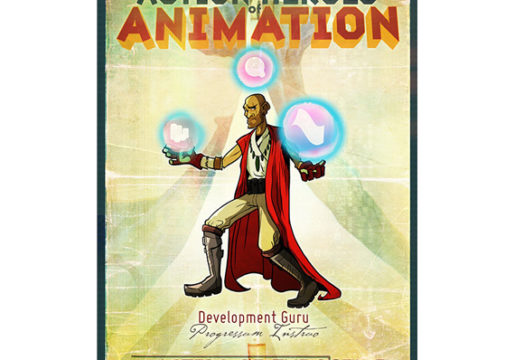
In a previous post I introduced the 4 phases of the animation process using characters to help give an overview. Today, I’ll use one of the characters to further explain the first phase of the process and unpack 5 critical steps in the process.
Development Guru (Progressum Instruo) is a wise sage who’s here to guide you thru the tangled land of developing your idea, determining a budget, and mapping out a schedule. His special powers and years of battle-tested development techniques will help you on your journey thru the Development Jungle.
This first phase has to do with your concept itself. Occasionally, we have clients come to us with a complete concept developed but more often than not, clients come to us with a partly developed concept or just a basic idea. Our job in development is come up with a solution. What is the best concept to use to solve your problem? This is where experience and a development process is absolutely necessary.
1. RESEARCH
Research the demographics of the target audience, find out what creative approaches have been taken before for similar concepts (believe me, there’s nothing 100% new under the sun), determine what the concept possibilities are (style, setting, type of characters, unique situation, etc.), who the stake holders are, and why certain approaches may be more or less effective than others. This is also the phase where reference is gathered (or reference trips taken) to help with visual and treatment development.
2. FLESHING OUT THE CONCEPT
This is where the nebulous idea begins to take shape. The rules of the concept world are defined. Character personalities and back stories are fleshed out. Secondary characters are developed, and story arcs are crafted.
3. VISUAL DEVELOPMENT
Once we get a basic understanding of the concept, we move into visual development where we begin to design the look and feel of the concept. What do the characters look like? What do the backgrounds look like? What are the art direction rules of the concept.
4. TREATMENT
Once visual development is underway, we usually develop a treatment. A treatment is a short (5-25 page, depending on the scope) description of the concept, characters, world, special features, rules, etc. and has artwork to help convey these aspects.
5. SCRIPT
Once the treatment is approved we write a script. Everything leading up to the script is absolutely necessary and helps make for a great script. Fully developed characters (likes, dislikes, strengths, weaknesses, quirks, backgrounds) and the specifics of their interpersonal dynamics will GREATLY influence and strengthen the script. The more time you spend in development the more interesting and stronger your project will be.
CONCLUSION
This is the foundation of the house. You can’t go back (without additional time and money) once you move into pre-production. Think of the development phase as the blue prints for a house. You don’t want to start cutting 2×4′s and pouring concrete until the blue prints are finalized. Development is the surveying and architectural process for any creative story and character driven project.
This process can take a few weeks (for small projects), a few months (for medium sized projects), or a year or more (for very large projects). TV shows are often in development for 1-3 years and animated feature films even longer. Pixar films, for example, have a minimum 4 year development phase (in most cases).
Once the planning, concept, final script, and key visual development are all completed, it’s time to move down the pipeline to Pre-Production.
